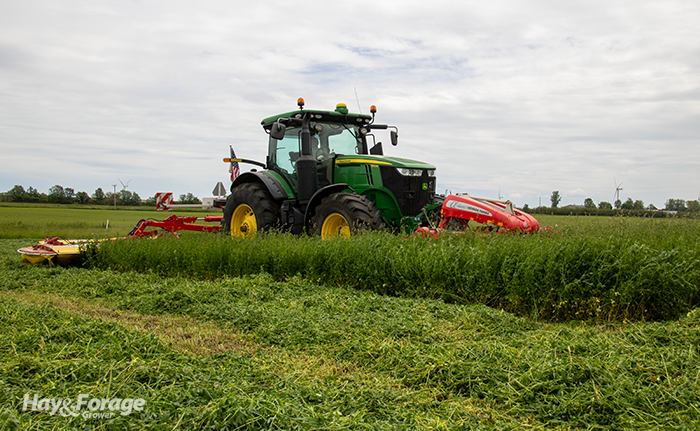
The colder months ahead require farmers to winterize hay equipment, take inventory of stored forages, and draw up plans to feed livestock. As we wrap up forage production for 2025, it’s a good time to reflect on what went wrong, what went right, and what’s on the docket for 2026.
In addition to analyzing temperature and precipitation patterns, drought monitor maps, market reports, and hay export data, I reflected on my own on-farm experiences this year and touched based with some farmers to get their take on forage production and hay prices. Overall, I received disgruntled feedback about the weather, the negative effects it had on forage quality, and heard some grumblings about hay prices, considering the market’s downward trend. The following is a summary of my biggest takeaways from the 2025 growing season.
The forecast was unforgiving. An extremely wet spring turned into an extremely dry summer for forage producers across the country. Especially in the central U.S., persistent spring rains set back the first cutting of hay. As a result, forage quality was reduced, and that delay set the tone for a challenging harvest season defined by late cuttings, frustrating field conditions, and a surplus of low-quality hay.
One hay producer I spoke to from central Kentucky contended that 2025 was the worst growing season he has ever experienced. Kevin Priddy, who farms near Clarkson, Ky., recalled that early season precipitation sabotaged the quality of the straight alfalfa, alfalfa-orchardgrass, and mixed grass hay that he bales for the equine market. He purported that many other farmers can relate.
“Good-quality hay is very scarce this year,” he said. Even when the forecast offered enough dry days to cut hay, some of his bales got rained on before they could be hauled off the field. The saturated soils were difficult to drive across without getting big equipment stuck, and at one point, Priddy went in with hay wagons and picked up small square bales by hand.
“I haven’t done that in 15 years,” he said.
Then, the summer turned dry for central Kentucky, as well as a large swath of the rest of the U.S. By late September, Priddy thought conditions had improved enough to move forward with some fall forage seedings, but then Mother Nature changed her mind again.
“It started raining, but instead of just showers, we got big rains that gutted the field,” he said. “It’s just been a nightmare all year long.”
New alfalfa seedings also appear to be in rough shape on his farm. He said he’s worried about the young plants’ ability to overwinter. He’s also concerned for alfalfa persistence and harvest efficiency long term after torrential rains caused significant water erosion in those stands.
Despite disease pressure, corn silage turned out okay. According to USDA Crop Progress reports, 2025 corn planting was on time or ahead of schedule compared to 2024, especially throughout the Corn Belt. When the water shut off in midsummer, though, many fields got dry. The combination of early season wetness and late season drought stress fueled a high frequency of stalk and leaf diseases, including tar spot and southern rust.
Even so, a dry August and September offered favorable chopping conditions in many regions, and farmers who were proactive in disease and harvest management may call this year’s corn silage season an overall success. Testing silage will still be important to assess forage quality before formulating rations, especially considering the effects drought stress may have had on nutrient concentrations.
La Niña won’t make a huge impact this winter. Meteorologists and climatologists declared La Niña was in effect in early October based on the cooler-than-normal sea surface temperatures in the tropical Pacific Ocean, but many sources say it will likely be a weak event that leads into a neutral spring. In fact, some experts say La Niña may not even fully develop. Rather, they predict weather patterns will only moderately resemble what would be expected during a full-fledged La Niña year, in which case the northwest half of the United States generally experiences cooler and wetter conditions and the southeast half is warmer and drier than average.
Hay prices continue to creep lower. Average hay prices are still on a downward slide after reaching historic highs a few years ago. So far in 2025, the average price across all quality types of alfalfa hay peaked in May at $191 per ton, and the most recent data available from USDA hay reports show that number dropped to $166 per ton in August. Average alfalfa hay prices have trailed those posted in 2024 every month this year.
Since the hay market is cyclical in nature, typically peaking in April or May, it would be fair to assume prices will continue to decline over the next few months. Soft hay prices can be influenced by commodity feed prices, which recently hit five-year lows.
With that said, average hay prices vary by region, and regional data might not represent what’s happening on a local scale. Average hay prices also may not resonate with producers who maintain a more consistent price range from year to year. Although the tradeoff of this pricing strategy is selling hay for less than market value during good years, it provides a cushion during down years when hay prices are locked in before the growing season begins.

